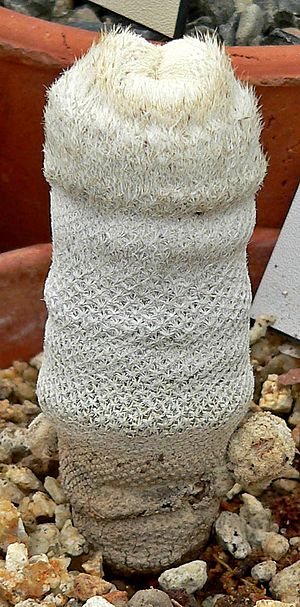Pingpong ball cactus facts for kids
Quick facts for kids Pingpong ball cactus |
|
|---|---|
 |
|
| Scientific classification | |
| Genus: |
Epithelantha
|
| Species: |
bokei
|
Epithelantha bokei is a special kind of cactus that people often call the pingpong ball cactus or button-cactus. It gets these names because of its small, round shape. This unique plant grows naturally in parts of Texas in the United States and Coahuila in Mexico.
Contents
What Does the Pingpong Ball Cactus Look Like?
This cactus is usually shaped like a flat disc or a small cylinder. It typically does not have branches and has a flat top. It measures about 2 to 5 centimeters (about 1 to 2 inches) wide. The cactus is covered so thickly with pale spines that it looks white or yellowish. Each small bump on the cactus, called an areole, can have up to 90 spines. The longest spines are about 7 millimeters (less than half an inch) long.
The Epithelantha bokei cactus produces delicate pale pink flowers. These flowers can be up to 1.7 centimeters (about two-thirds of an inch) long and wide. After the flowers, the plant grows red fruit that is about a centimeter (less than half an inch) long. Most of this cactus actually grows underground, with only a few centimeters showing above the soil. When the weather is very dry, the plant can shrink and pull itself further into the ground to stay safe.
Where Does the Pingpong Ball Cactus Live?
This cactus prefers to grow on rocky or gravelly ground. It especially likes areas with limestone rocks. Its natural home is in dry, desert-like regions of Texas and Coahuila.
What Harms This Cactus?
Unfortunately, the Epithelantha bokei cactus faces some dangers. One big threat is poaching, which means people illegally take the plants from their natural homes. Another problem is habitat degradation. This happens when the places where the cactus lives are damaged or changed, often by human activities. These threats make it harder for this special cactus to survive in the wild.
How is it Protected?
To help protect this unique plant, some Epithelantha bokei cacti are grown in special gardens. For example, you can find them growing at the Desert Botanical Garden in Phoenix, Arizona. This helps scientists study the plant and keep it safe.
How Did it Get Its Name?
The scientific name Epithelantha bokei honors a person named Norman H. Boke. He was a plant anatomist, which means he studied the inside structures of plants. He was also a student of the Cactaceae family, which is the scientific name for all cacti.

